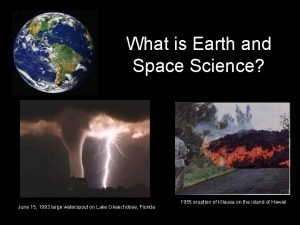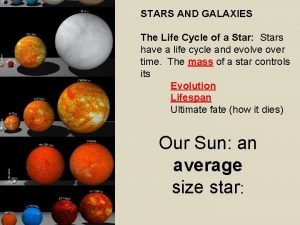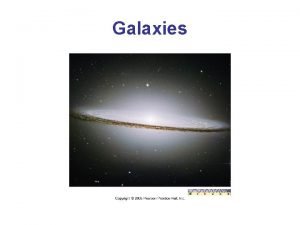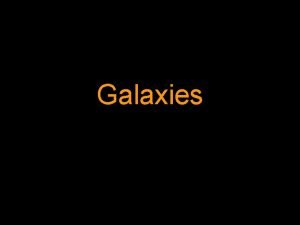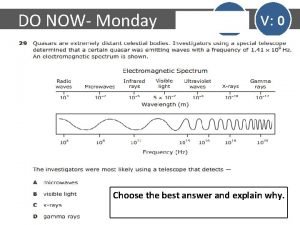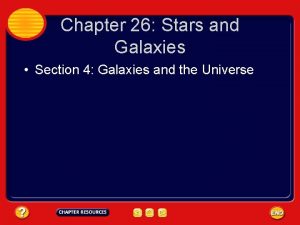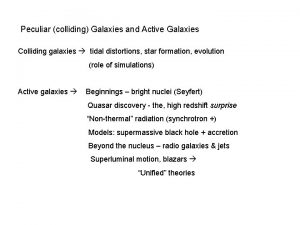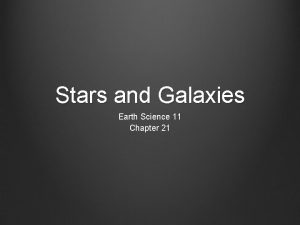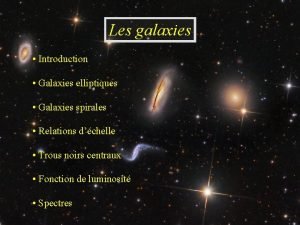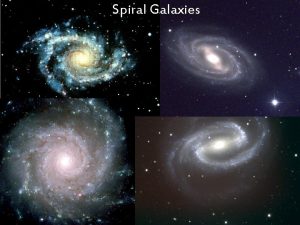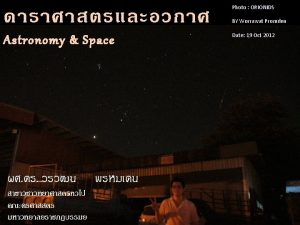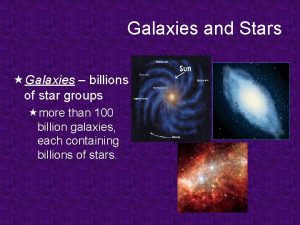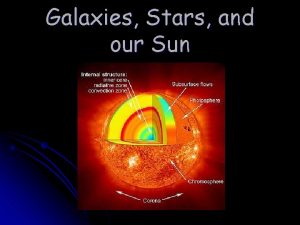EARTH SPACE SCIENCE Chapter 30 Stars Galaxies and

















- Slides: 17

EARTH & SPACE SCIENCE Chapter 30 Stars, Galaxies, and the Universe 30. 3 Star Groups

30. 3 Star Groups Objectives Describe the characteristics that identify a constellation. Describe three main types of galaxies. Explain how a quasar differs from a typical galaxy.

Constellations Dividing Up the Sky n n n A constellation is one of 88 regions into which the sky has been divided in order to describe the locations of celestial objects; a group of stars organized in a recognizable pattern. In 1930, astronomers around the world agreed upon a standard set of 88 constellations. You can use a map of the constellations to locate a particular star.

Constellations Naming Constellations n n Many of the modern names we use for the constellations come from Latin. Some constellations are named for real or imaginary animals, such as Ursa Major (the great bear) or ancient gods or legendary heroes, such as Hercules or Orion. http: //www. physics. unlv. edu/~jeffery/astr o/constellation. html

The Constellation Orion

Multiple-Star Systems Over half of all observed stars form multiplestar systems. Binary stars are pairs of stars that revolve around each other and are held together by gravity. The center of mass, or barycenter, is somewhere between the two stars. In star systems that have more than two stars, two stars may revolve rapidly around a common barycenter, while a third star revolves more slowly at a greater distance from the pair.

Sirius A & B http: //ircamera. as. arizona. e du/Astr 170 B 1/N at. Sci 102/lectures/otherstar s. htm

Star Clusters Sometimes, nebulas collapse to form groups of hundreds or thousands of stars called clusters. Globular clusters have a spherical shape and can contain up to 100, 000 stars. An open cluster is loosely shaped and rarely contains more than a few hundred stars.

Galaxies A galaxy is a collection of stars, dust, and gas bound together by gravity. Galaxies are the major building blocks of the universe. Astronomers estimate that the universe contains hundreds of billions of galaxies. A typical galaxy, such as the Milky Way, has a diameter of bout 100, 000 light-years and may contain more than 200 billion stars.

Galaxies Distances to Galaxies n n Giant stars called Cepheid variables brighten and fade in a regular pattern. Most Cepheids have regular cycles. The longer the cycle, the brighter the star’s absolute magnitude. Scientists compare the Cepheid’s absolute magnitude and the Cepheid’s apparent magnitude to calculate the distance to the Cepheid variable. This distance tells scientists the distance to the galaxy in which the Cepheid is located.

Galaxies Types of Galaxies n n Galaxies are classified by shape into three main types. A spiral galaxy has a nucleus of bright stars and flattened arms that spiral around the nucleus. Elliptical galaxies have various shapes and are extremely bright in the center and do not have spiral arms. An irregular galaxy has no particular shape, and is fairly rich in dust and gas.

Three Types of Galaxies http: //kids. britannica. com/comptons/art-90846/In-the-1920 s-Edwin-Hubbleseparated-galaxies-into-four-general

The Milky Way The galaxy in which we live, the Milky Way, is a spiral galaxy in which the sun is one of hundreds of billions of stars. Two irregular galaxies, the Large Magellanic Cloud and Small Magellanic Cloud, are our closest neighbors. These three galaxies are called the Local Group.

Quasar A quasar is a quasi-stellar radio source; a very luminous object that produces energy at a high rate. Quasars appear as points of light, similar to stars. Quasars are located in the centers of galaxies that are distant from Earth. Quasars are among the most distant objects that have been observed from Earth.

http: //astro. unl. edu/classaction/outlines/galaxies/quasars. html

Video Links A Guide To Learn About The Constellation (3: 59) - http: //youtu. be/u. KXBt. WHExw. Q Welcome to the Hubble Universe: Nebula & Galaxies: A Cosmic Journey (14: 38) http: //youtu. be/X 5 z. Vl. Eyw. GZg How do we know how many galaxies there are in the Universe? (4: 58) http: //youtu. be/b. ENTu. Gmw 0 Sg Artist's impression of the quasar 3 C 279 (0: 25) http: //youtu. be/h. Ch. AVI 9 E 9 Kc

Video Links Cosmic Journeys: Birth of a Black Hole (25: 01) - http: //youtu. be/7 h_m. B 0 WW 0 j. M
 What waves are produced by stars and galaxies
What waves are produced by stars and galaxies Chapter 30 galaxies and the universe
Chapter 30 galaxies and the universe The stars there are millions of stars in the sky
The stars there are millions of stars in the sky Earthology definition
Earthology definition Spiral irregular and elliptical galaxies
Spiral irregular and elliptical galaxies Life cycle of a galaxy
Life cycle of a galaxy Facts about elliptical galaxies
Facts about elliptical galaxies Th eirregulars
Th eirregulars The pity relation for an adiabatic expansion is
The pity relation for an adiabatic expansion is Most galaxies in the inner region of a large cluster are
Most galaxies in the inner region of a large cluster are Types of galaxies
Types of galaxies Brainpop galaxies quiz answers
Brainpop galaxies quiz answers 4 types of galaxies
4 types of galaxies How are active galaxies classified?
How are active galaxies classified? Tipus de galaxies
Tipus de galaxies Properties of elliptical galaxies
Properties of elliptical galaxies Evolution of galaxies
Evolution of galaxies Billions of galaxies
Billions of galaxies



